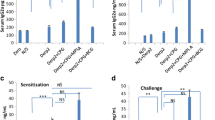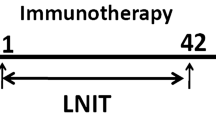Summary
The generation and/or expression of suppressor T lymphocytes (Ts) in contact allergy to 2,4-dinitrofluorobenzene (DNFB) is inhibited by treatment of BALB/c mice with C. parvum. It has been described that C. parvum injected intravenously (IV) or intraperitoneally (IP) suppresses lymphocytic responses via activated macrophages. In this investigation we compared Ts and T-effector lymphocytes of delayed hypersensitivity (TDH) inhibition and suppression of mitogen-induced spleen lymphocyte proliferation by C. parvum to find some correlation between these effects of C. parvum. Various times after IP injection of C. parvum BALB/c mice were tolerized (a) by an epicutaneous antigen overload, (b) by 2,4-dinitrobenzene (DNBSO3 IV, (c) by injection of Ts cells from tolerant donors, or (d) sensitized with an optimal dose (15 μl) of DNFB.
Suppressor and effector cell generation and/or function was assessed by sensitization (2×0.5% DNFB) and challenge at the right ear or by transfer of spleen cells from the C. parvum-treated or-untreated tolerized donor to the C. parvum-treated or-untreated recipient, followed by sensitization and challenge of the recipient. From the same pool of C. parvum-treated or-untreated animals, spleens were obtained, weights determined, spleen cells prepared, and mitogen (phythemagglutinin or concanavalin A)-induced lymphocyte proliferation measured.
The results show that C. parvum-mediated inhibition of Ts generation in the donor mice correlated — although not entirely — with suppression of mitogen-induced lymphocyte proliferation. Inhibition of Ts function in the recipient by C. parvum did not correlate with suppression of spleen lymphocyte proliferation, i.e., Ts function was inhibited up to 1 week only. Lymphocyte proliferation, however, was inhibited up to 3 weeks after C. Parvum injection. Sensitization of mice was inhibited by C. parvum shortly after injection; 1 week after C. parvum injection, no inhibition of contact sensitivity was observed. These results suggest that Ts-cell generation might be suppressed by a similar mechanism as described for suppression of lymphocyte proliferation, i.e., via suppressive factors released from C. parvum-activated macrophages, however, Ts-cell function appears not to be inhibited by this mechanism. T-effector cells of delayed hypersensitivity are very little affected by C. parvum-mediated suppression.
Similar content being viewed by others
Abbreviations
- DNFB:
-
2,4-dinitrofluorobenzene
- DNBSO3 :
-
2,4-dinitrobenzene sulfonic acid
- Ts :
-
suppressor T-lymphocyte
- TDH :
-
T-effector lymphocyte of delayed hypersensitivity
References
Knop J, Riechmann R, Macher E (1981) Modulation of suppressor mechanisms in allergic contact dermatitis. I. Effect of C. parvum on the induction phase of contact allergy. J Invest Dermatol (in press)
Knop J, Riechmann R, Macher E (1981) Modulation of suppressor mechanisms in allergic contact dermatitis. II. Inhibition of suppressor T-lymphocytes by C. parvum. J Invest Dermatol (in press)
Sljivic VS, Watson SR (1977) The adjuvant effect of Corynebacterium parvum: T-cell dependence of macrophage activation. J Exp Med 145:45–57
Scott MT (1972) Biological effects of the adjuvant Corynebacterium parvum. II. Evidence for macrophage-T cell interaction. Cell Immunol 5:469–479
Phanuphak P, Moorhead JW, Claman HN (1974) Tolerance and contact sensitivity to DNFB in mice. 1. In vivo detection by ear swelling and correlation with in vitro cell stimulation. J Immunol 112:115–123
Kirchner H, Holden HT, Herberman RB (1975) Splenic suppressor macrophages induced in mice by injection of Corynebacterium parvum. J Immunol 115:1212–1216
Sy MS, Miller SD, Claman HN (1977) Immune suppression with supraoptimal doses of antigen in contact sensitivity to DNFB. J Immunol 119:240–244
Kirchner H, Glaser M, Herberman RB (1975) Suppression of cell-mediated tumor-immunity by Corynebacterium parvum. Nature 257:396–398
Lee K-C, Berry D (1977) Functional heterogeneity in macrophages activated by Corynebacterium parvum: characterization of subpopulations with different activities in promoting immune responses and suppressing tumor cell growth. J Immunol 118:1530–1540
Sy MS, Miller SD, Kowack HB, Claman HN (1977). A splenic requirement for the generation of suppressor cells. J Immunol 119:2095–2099
Gemsa D, Steggemann L, Till G, Resch K (1977) Enhancement of the PGE1 response of macrophages by concanavalin A and colchicine. J Immunol 119:524
Neumann C, Sorg C (1977) Immune interferon. I. Production by lymphokine-activated murine macrophages. Eur J Immunol 7:719–725
Lopatin DE, Ranney DF (1977) Maintenance of the resting state and potential regulators of the proliferate phase. In: Lucas DO (ed) Regulatory mechanisms in lymphocyte activation. Academic Press, pp 195–218
Author information
Authors and Affiliations
Rights and permissions
About this article
Cite this article
Knop, J., Riechmann, R. & Macher, E. Effect of Corynebacterium parvum-mediated inhibition of lymphocyte proliferation on the effector-and suppressor-lymphocyte response in contact allergy. Arch Dermatol Res 273, 15–23 (1982). https://doi.org/10.1007/BF00509023
Received:
Issue Date:
DOI: https://doi.org/10.1007/BF00509023




